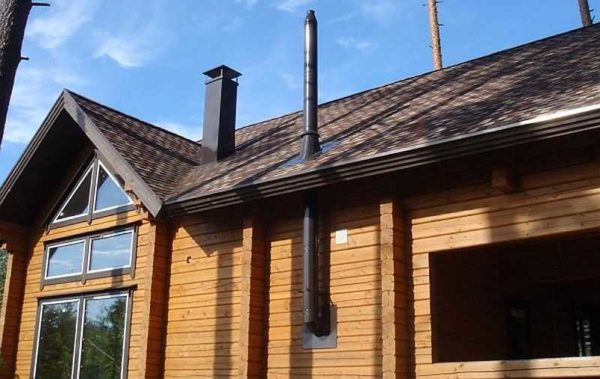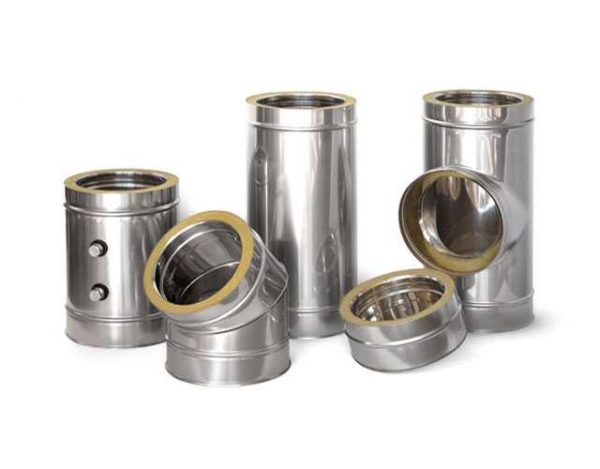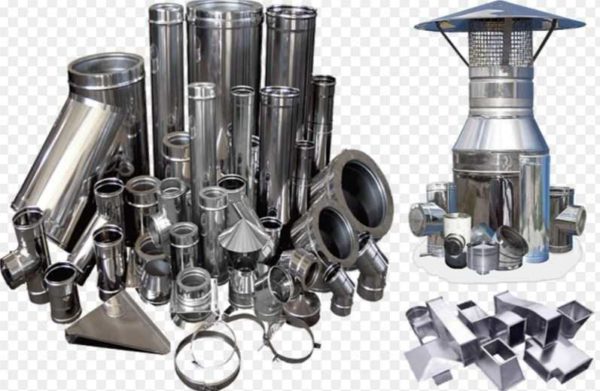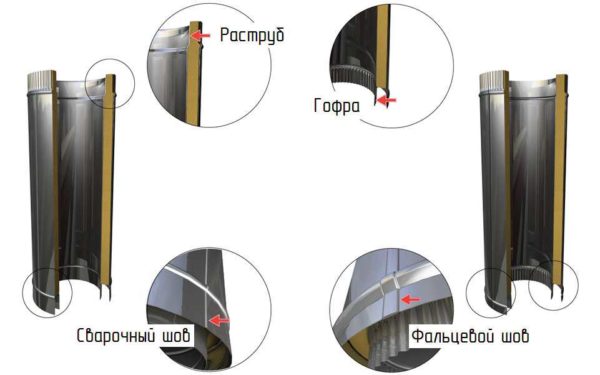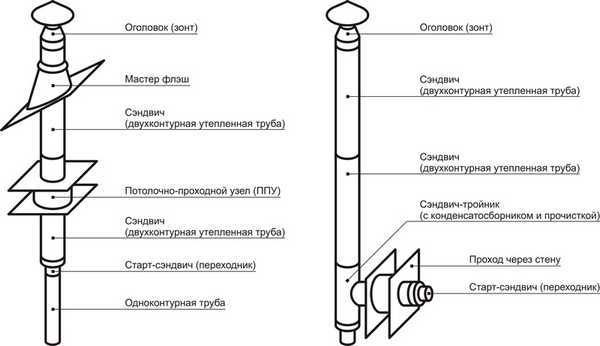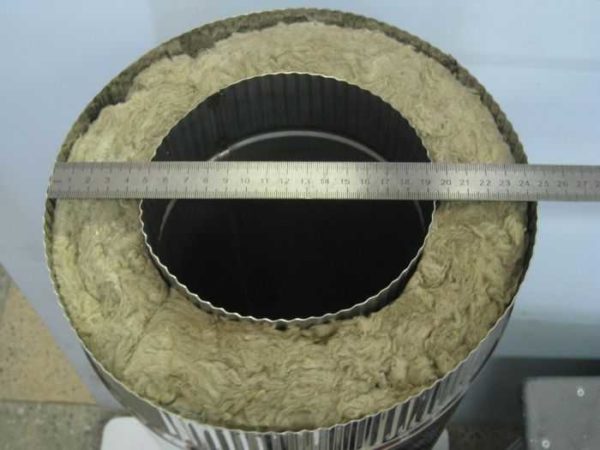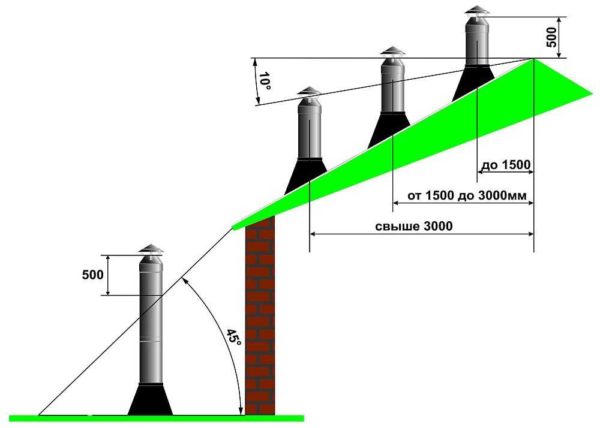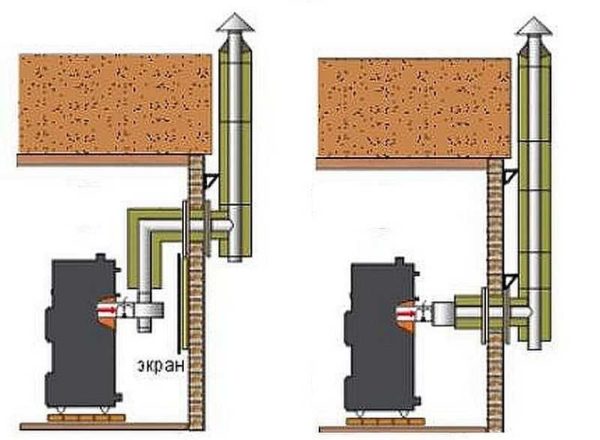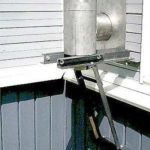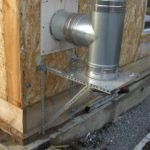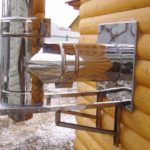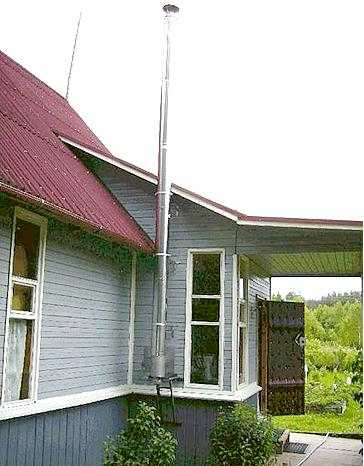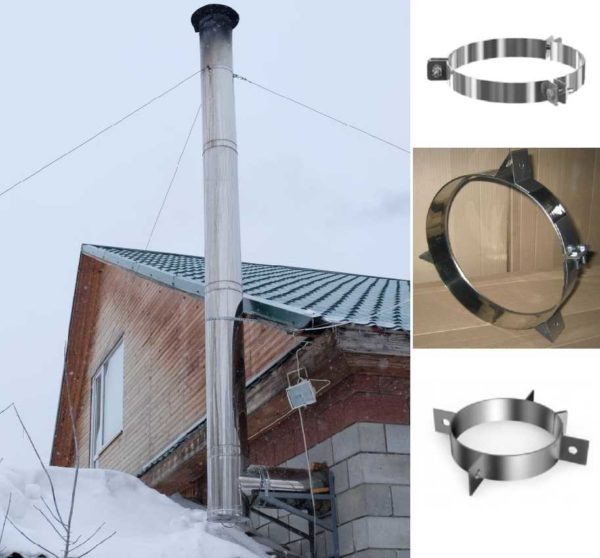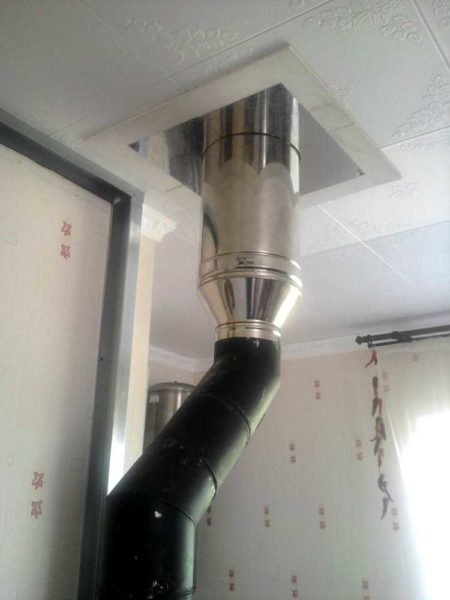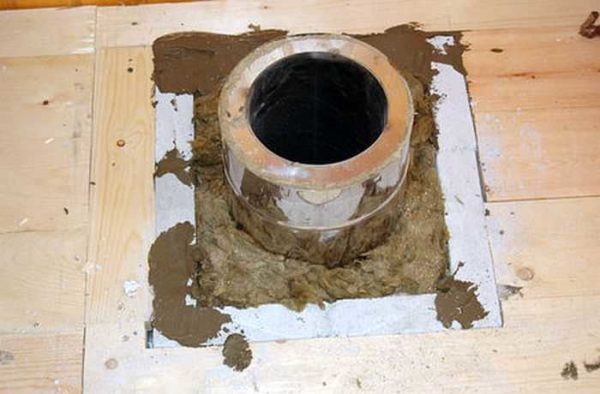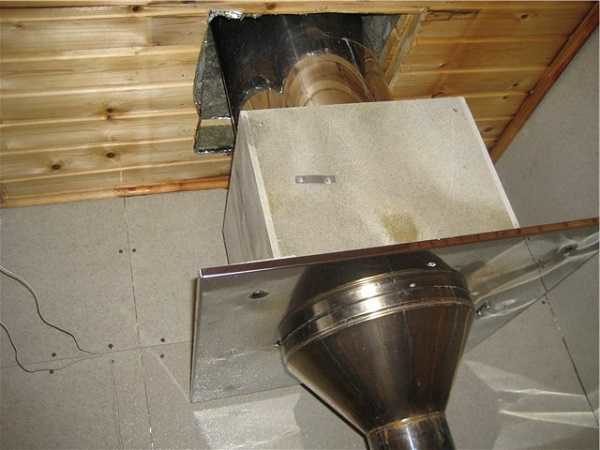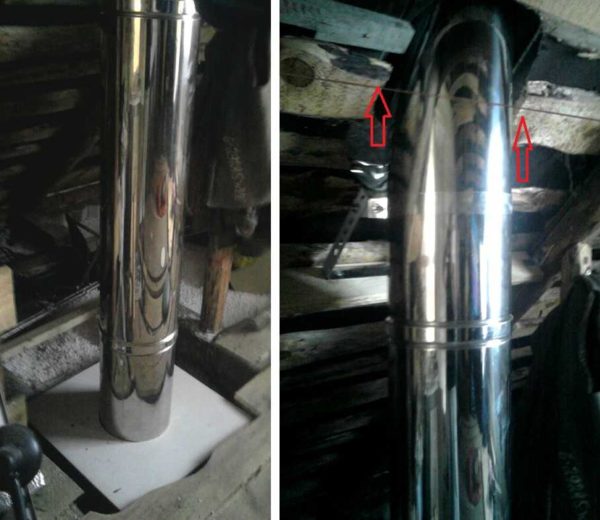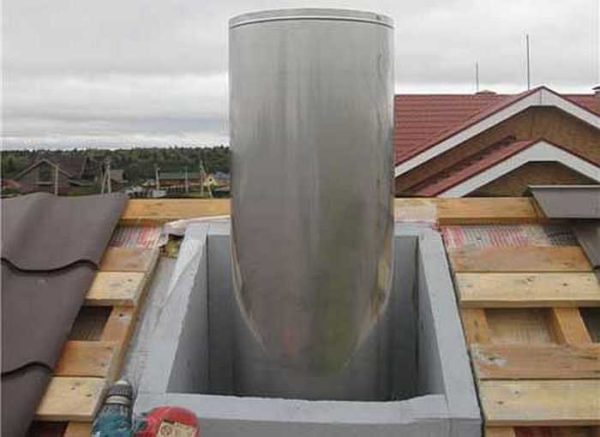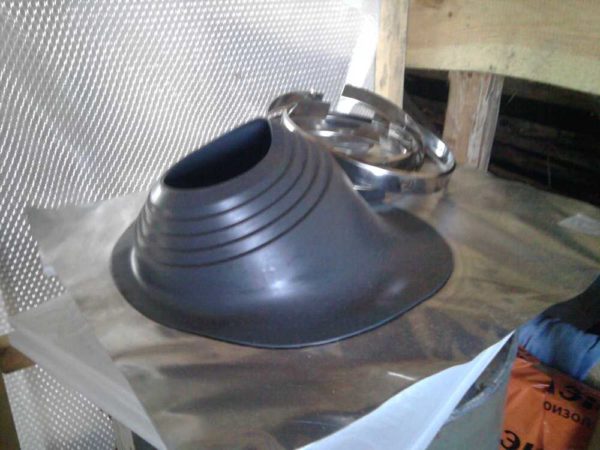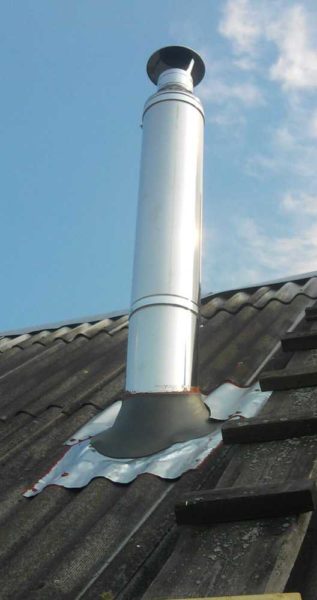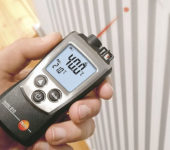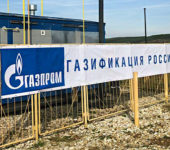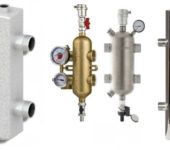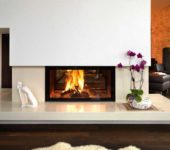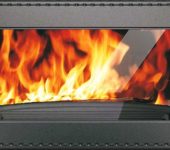How to install a sandwich pipe chimney
In recent years, more and more chimneys are made from sandwich pipes. The point is the relatively low price, long service life, quite attractive appearance. It is also important that independent installation of a sandwich chimney is possible. This is not a very simple matter - there are many nuances, but you can do it yourself, without involving specialists.
The content of the article
What is a sandwich pipe and what are they?
The sandwich pipe was named so for its multi-layer: there are two layers of metal, between which there is a heater. This structure solves many of the problems that were inherent in a simple chimney from a metal pipe. Firstly, the insulation layer does not allow the outer metal casing to heat up to critical temperatures; no hard radiation emanates from the pipe. The room creates more comfortable conditions. Secondly, the same insulation significantly reduces the amount of condensate that forms when the pipe is taken out into the street. Thirdly, since the outer casing no longer has such a high temperature, it is easier to make the passage of the chimney through the roof or wall.
What materials are they made of
Sandwich pipes are made of galvanized or stainless steel. Galvanized sandwich pipes for chimneys are rarely used. Is that for the removal of combustion products of a low-power wall-mounted gas boiler or gas water heater. Can be used for insulated ventilation. For more serious heating devices, they are unsuitable - at high temperatures, zinc burns out, steel quickly rusts, and the chimney becomes unusable.
Sandwich pipes for high-temperature flue gases are made of stainless steel. Moreover, stainless steel is used in different grades - from alloys with a small content of alloying metals to high-alloy heat-resistant ones. The thickness of the metal may be different - from 0.5 to 1 mm, as well as the thickness of the insulation - 30 mm, 50 mm and 100 mm. It is clear that the scope of application will be different, and the price too.
The main steel grades that are used in the production of sandwich pipes for chimneys, their purpose and main characteristics are summarized in the table.
| Stainless steel grade | Main characteristics | Application area |
|---|---|---|
| AISI 430 | Possesses sufficient resistance to weathering, but does not tolerate high temperatures | Used for outer shells of sandwich pipes |
| AISI 439 | Contains titanium, which increases resistance to high temperatures and aggressive environments. | Suitable for gas boilers, low-power solid fuel units (up to 30 kW) |
| AISI 316 | Alloying additives - nickel and molybdenum - give high resistance to acids, increased heat resistance. | Optimal for all types of gas boilers. |
| AISI 304 | Cheaper version of AISI 316 with less alloying | Economy option for gas boilers of medium and low power |
| AISI 316I, AISI 321 | Withstand temperatures up to 850 ° C | Can be used for heating solid fuel stoves |
| AISI 310S | Increased thermal stability - up to 1000 ° C (and price) | For bath and pyrolysis solid fuel stoves |
As you can see from the table, different grades of stainless steel have different purposes. Cheaper alloys are used for the outer casing, while the more heat-resistant and expensive alloys are used for the inner. This is necessary to reduce the cost of production, and high resistance to temperatures outside the chimney is not needed.There are even more budget options - the outer casing is made of galvanized steel. Outwardly, these products are inferior to stainless, but they serve normally (with normal insulation and its thickness).
Insulation and its thickness
There is insulation between the two layers of metal. Most often it is stone wool. The thickness of the insulation is from 30 to 100 mm:
- With thermal insulation 30 mm thick, the flue gas temperature should not exceed 250 ° C. Such temperatures are given only by gas boilers of small and medium power.
- Insulation layer of 50 mm allows to withstand temperatures up to 400 ° C. Scope - any gas and liquid fuel boilers, wood-burning, subject to the output of the chimney to the street (through the wall).
- A 100 mm layer of rock wool can withstand temperatures up to 850 ° C. Such a sandwich chimney can be installed on any type of solid fuel boiler, in fireplaces and hearths.
In addition to the thickness of the insulation, you need to pay attention to its brand, or rather, to the temperature range in which it can work. Not every stone wool can withstand heating up to 850 ° C, but only some special grades. If you need a chimney for a solid fuel boiler, you will also have to take into account the thermal resistance of the insulation.
Connection types
The elements of the chimney sandwich can be interconnected in two ways: with sockets and corrugated edges. A socket connection assumes a slightly wider chamfer on one side. With this design, a high degree of chimney tightness is achieved. This type of sandwich pipe is well suited for gas boilers, where it is important to prevent leakage. There is also a minus: installation requires high precision.
The corrugated edge of the sandwich makes it easy to assemble the chimney. The disadvantage of such a solution is that a significant amount of high-temperature sealant is required to ensure tightness, and it costs a lot.
Also pay attention to the longitudinal seam. It can be welded or folded. If the seam is welded, it must be made in an argon protective environment (so as not to burn out alloyed metals). It is this type of connection that is required for solid fuel boilers, sauna stoves and fireplaces. For all others, a folded joint can also be used.
Installation methods
There are two ways to lead the chimney outside. The first is to pass the pipe through the wall, and then raise it along the outer wall to the required level. The second is upward through the ceiling and roof. Both are imperfect.
If the chimney is outside, due to the temperature difference, condensation is actively formed in it. Therefore, in the lower part of the chimney, a tee with a condensate trap (glass) and a cleaning hole must be installed. This unit allows maintenance of the chimney without much difficulty: the glass is unscrewed, the condensate is drained. Also, soot periodically gets lost without any problems - a special brush for the chimney can be run through the cleaning hole.
If the chimney is to be led out through the roof, several passages will be needed - according to the number of overlaps. If the house is one-story, you will need one pass through the ceiling and the second through the roof. You will also need a master flash or an apron for a round galvanized pipe.
Installation of a sandwich chimney on the street requires only one pass-through unit - through the wall. But it will be necessary to fix it to the wall every 1.5-2 meters. If the walls of the building are flammable (a wooden house or a frame), the walls must be protected with a non-combustible screen.
Smoke or condensation
Pipe height
The height of the chimney above the roof surface depends on the place of its outlet, but at the same time its minimum height should be 5 m.That is, if the height of the house is small, in any case bring the pipe to a height of 5 meters. If the height of the house is higher than 5 m, then the pipe should rise above the roofing material to the following height:
- Should rise 50 cm above the ridge if it comes out at a distance of less than 150 cm from it.
- If the distance from the ridge to the pipe is more than 300 cm, then the pipe may be lower than the level of the ridge, but the angle should be no more than 10 ° (see figure).
- If the chimney exits at a distance of 150 to 300 cm from the ridge, its height can be at the same level with the ridge element or higher.
Under these conditions, normal traction is ensured. The smoke will go off normally regardless of the weather conditions. To prevent foliage from entering the chimney, they put special umbrellas, weather vans, and in windy places - deflectors, which further improve traction.
If it is impossible to bring the pipe to such a height, they put a smoke exhauster - a forced draft is obtained. The fan will not be needed all the time, but in some conditions, when natural draft is not enough, forced draft saves the day.
Installation of a sandwich chimney through the wall
There are two ways to run the chimney through the wall. The first option (in the photo on the left) is to raise it in the room closer to the ceiling, and bring it out there. The second is to draw a conclusion at the level of the flue pipe from the boiler. In this case, almost the entire chimney is outside.
The second option is preferable - it has only one knee, which means, under equal conditions, the traction will be better. Also, with this structure, there is less chance of the formation of soot plugs.
If the outlet of the chimney is not at the back of the stove, but at the top, the installation scheme changes slightly - a 90 ° elbow is added, then a straight section for passing through the wall, and then as in other schemes.
The stove itself is placed on a non-combustible base, the wall behind the stove is closed with a non-combustible screen. The easiest way is to fix a sheet of metal on the wall. It can be mounted on ceramic insulators 2.5-3 cm in height. There will be an air gap between the sheet of metal and the wall, so the wall is safe. The second option is to put heat-insulating material under the metal - for example, mineral wool cardboard. Another option is an asbestos sheet (as in the photo).
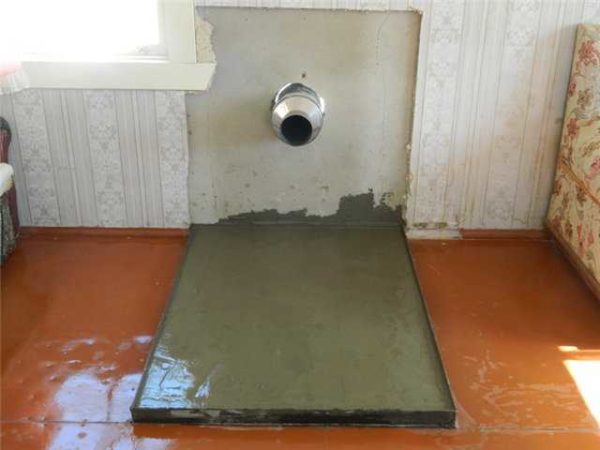
Preparation of the site for the installation of the furnace and the PPU installed in the wall with a piece of pipe
A hole is made in the wall. Its dimensions are determined by SNiP - the distance from the pipe to non-combustible walls must be at least 250 mm from all sides, and 450 mm to combustible walls. It turns out to be a solid hole, especially when it comes to walls made of combustible materials. There is one point with which you can reduce the size of the hole for the sandwich passage: make the dimensions according to the norms of non-combustible walls and sheathe the opening with non-combustible material.
The opening can be round or square, as long as the fire safety standards are maintained. It is easier to make and sheathe square holes, therefore they are more often made.
A pass-through unit is inserted into this hole - a box made of non-combustible material. A sandwich chimney pipe is inserted into it, fixed in the center. All gaps are filled with heat-resistant insulation, the hole is closed on both sides with non-combustible material. This is usually a sheet of metal.
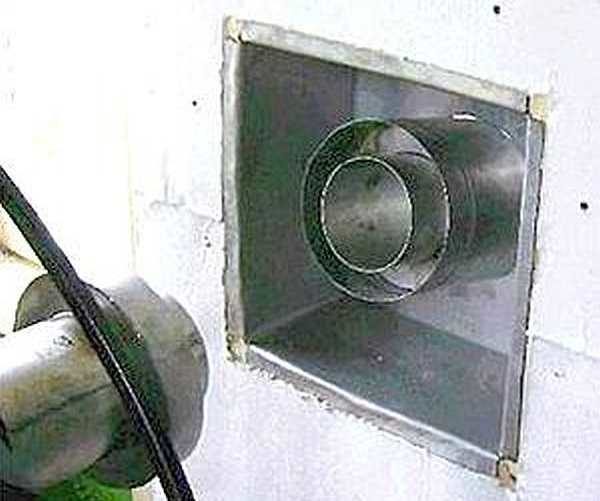
From the side of the room, a pass-through node is inserted. In this case, it is made of minerite, but it can also be metallic
One important point: the chimney must be designed so that there is no junction of two pipes inside the wall. All joints must be visible and maintainable.
Next, you need to make or install a ready-made support bracket that will hold the entire weight of the pipe. The design may differ in details, but the main idea is the same - a support platform, which, using stops, transfers weight to the wall.
- Homemade support platform for an outdoor chimney sandwich from corners 50 * 50 mm and 40 * 40 mm
- DIY perforated corner support platform
- U-shaped metal profile construction
A similar structure can be welded from a profile pipe of a small section 25 * 25 mm or 25 * 40 mm.
As you can see, a tee is connected to the pipe that goes through the wall. In the lower part there is a removable cup in which condensate accumulates. Some models have a fitting at the bottom with a small tap. This is even more convenient - you do not need to remove the glass, you can connect a hose to the fitting, take it out into some container (it is very toxic, so you do not need to drain it near the house) and drain it by simply turning the tap.
Then the tube is brought to the required level. Since in this case the distance to the ridge will obviously be more than 3 m, it is possible for the chimney height to be slightly lower than the ridge - not lower than 10 ° in relation to the horizontal line drawn from the ridge level.
But since this house is located in a lowland, to provide traction, the pipe was raised even higher than the ridge. It was fastened to the wall with stainless steel clamps, with a step of a little more than a meter. On the roof, there are braces made of a steel rod with a diameter of 6 mm. There are special clamps "with ears" to install the stretch marks, to which the stretch marks are attached.
Another important point that many people forget: at the place where the pipe is installed, a section of the snow guard must be installed on the roof, otherwise, in the spring, the pipe can be demolished with snow (if the pipe is not brought out towards the pediment, as in the photo).
How to install a chimney through the roof
When removing the chimney from the sandwich pipes through the roof, it is necessary to take into account the location of the floor beams and rafter legs on the roof. It is necessary to guess so that the pipe passes between these elements. The minimum distance from the outer wall of the pipe to the fuel element must be at least 13 cm, and this is provided that the fuel element is protected by a heater. To fulfill this requirement, the pipe often has to be displaced. Do this using two 45 ° angles.
Please note that the installation of a sandwich chimney from a solid fuel boiler begins with a metal pipe without insulation. In the photo above, it is black. After it, an adapter is placed on the sandwich, and a chimney with insulation enters the passage unit.
A hole is cut in the ceiling that meets fire standards - 250 mm from the edge of the pipe, if the ceiling is protected by thermal insulation material. Having cut the hole, its edges are closed with a non-combustible heat-insulating material. Minerite is best suited for this (nailed or fastened with self-tapping screws on wood).
A chimney sandwich pipe is inserted into the resulting box. It should be directed strictly vertically, without the slightest deviation. It cannot be rigidly fixed, you can only give direction by installing several planks that will hold it, but it can move up / down without difficulty. This is necessary, since when heated, its length increases significantly.
The remaining space is filled with basalt wool (check the temperature range). Another option is to pour expanded clay, granulated foamed glass. Previously, sand was still poured, but sooner or later, it all woke up through the cracks, so now this option is unpopular. On the front side, all this "beauty" is covered with a sheet of stainless steel, under which (between it and the ceiling) non-combustible material is placed. Previously, it was an asbestos sheet, but since asbestos is recognized as a carcinogen, they began to use mineral wool cardboard.
There is another option.Trim the edges of the hole with mineral wool, and then insert the finished stainless steel ceiling-pass assembly. It immediately contains both a box and a decorative stainless steel screen.
Having brought the pipe to the attic, they make a hole in the roofing pie. All films in the place of passage (vapor barrier and waterproofing) are cut crosswise. The resulting triangles are wrapped and secured with staples from a stapler. So the damage is minimal. The exposed crate is cut so that the pipe is at least 13 cm.
In the right photo above, the passage through the roof is incorrect - the distance between the pipe and the boards is too small. In an amicable way, you need to cut them off according to the standard, beat them with the same minerite. You should get something similar to the following photo.
Further, after laying the roofing material, a master-flush is put on the pipe, the skirt is given the desired shape (under the shape of the roofing material).
The rubber-pipe joint is sealed with a heat-resistant sealant. Also, the roof surface under the "skirt" is coated with a sealant.
Please note that each connection of the sandwich modules is tightened with a clamp. This is also true for the internal chimney.

